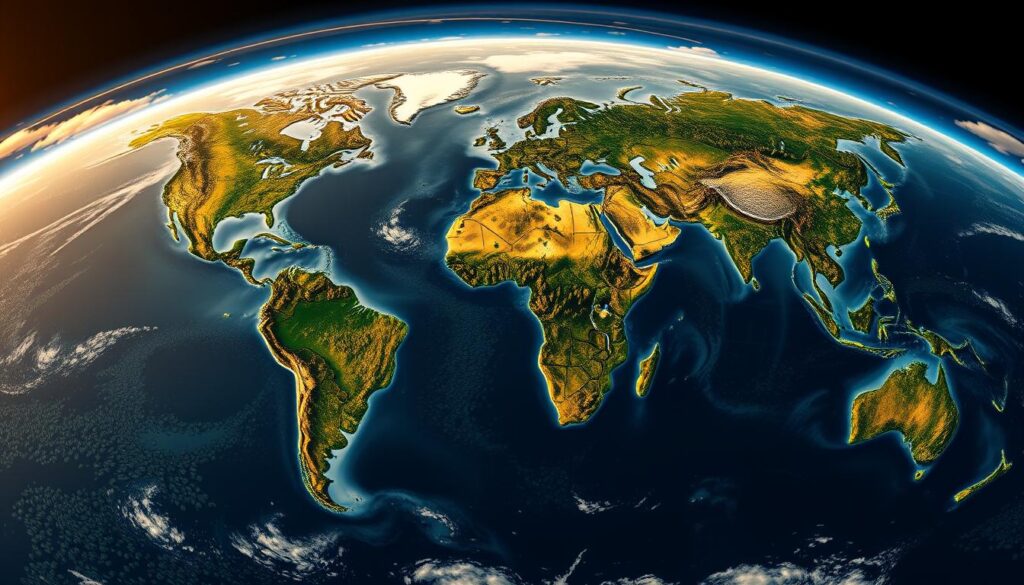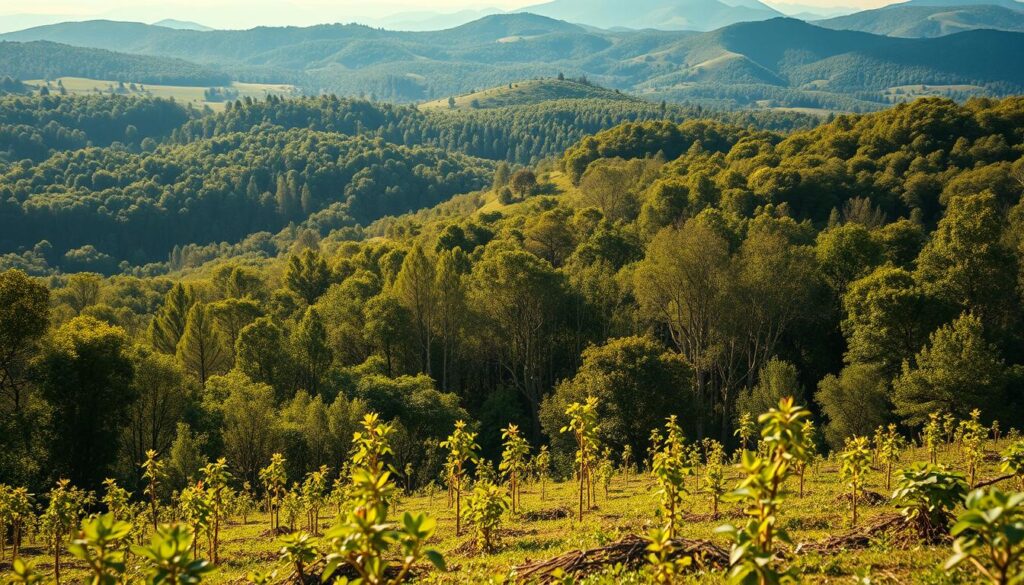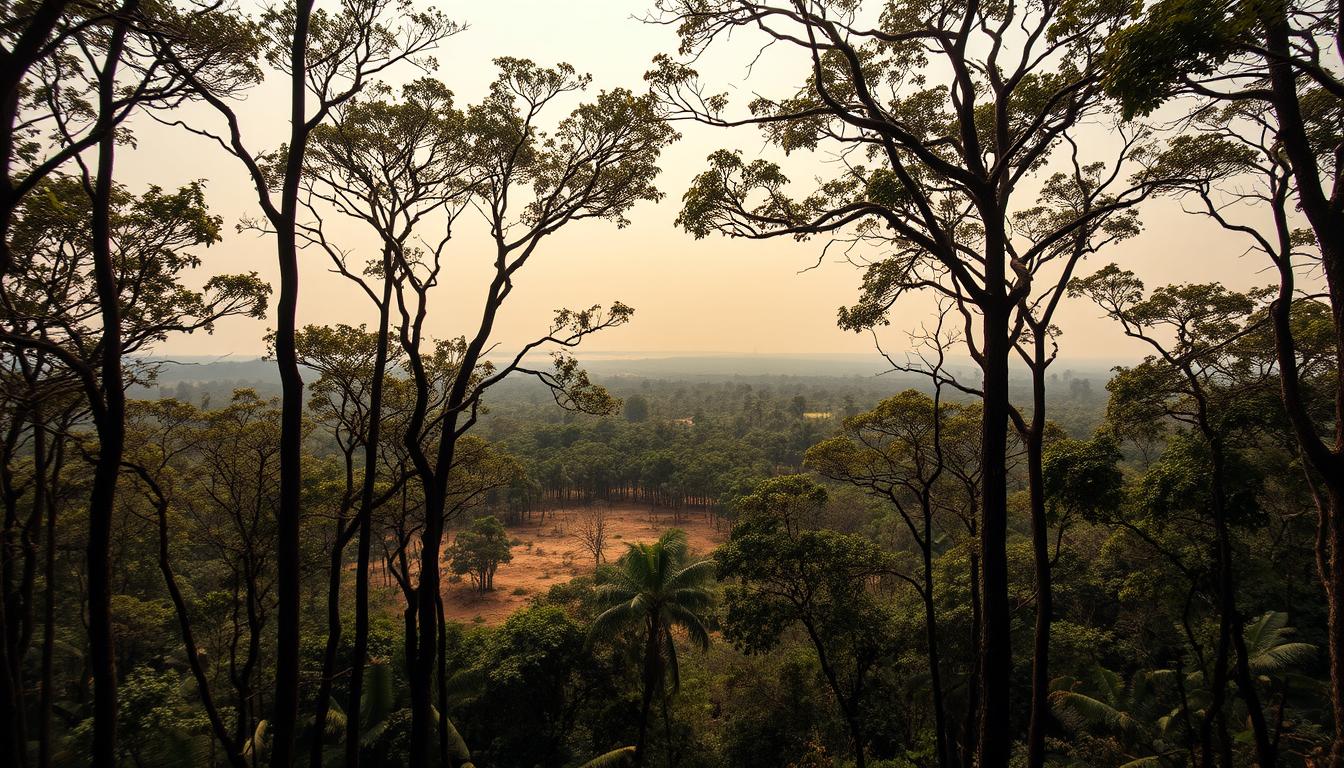Every time you breathe, you’re connected to the trees that protect our planet. As global warming speeds up, these living guardians are our strongest defense. Imagine a world where our Earth’s lungs are fading away, threatening our ecosystem’s balance.
Trees are key in fighting climate change. They cover 31% of our land, acting as huge carbon sinks. They absorb CO2 and release oxygen. Knowing how trees fight global warming could save our planet.
Soon, you’ll learn about the amazing ways trees battle our biggest environmental challenge. Get ready to be amazed by their incredible role in keeping our climate in check.
Table of Contents
The Critical Link Between Trees and Climate Change
Trees are nature’s strongest allies in the battle against global warming. Learning how they fight climate change changes how we see environmental sustainability.
Carbon sequestration is a key process where trees grab and hold carbon dioxide from the air. These green giants are natural climate controllers, playing a vital role in lowering greenhouse gas emissions.
Understanding the Carbon Capture Mechanism
Through photosynthesis, trees take in carbon dioxide and turn it into oxygen and plant material. This amazing process makes forests strong carbon sinks, helping to lessen climate change.
- Trees soak up about 30% of global CO2 emissions
- A grown tree can lock up to 48 pounds of carbon each year
- Forests keep local and global temperatures steady
Natural Climate Regulation Strategies
Forests create special microclimates that affect temperature, humidity, and rain. By releasing water vapor and giving shade, trees help control the environment and keep ecosystems balanced.
Global Temperature Control Dynamics
Your planet counts on forests as key temperature regulators. These vast green networks soak up sunlight, cut down heat island effects, and keep essential ecological balance for global climate stability.
Trees & Global Warming: Current Impact Assessment
Global temperatures have changed a lot in recent years. Trees are key in fighting climate change. Scientists have found a strong link between forests and global warming.
Research shows trees are vital in controlling the climate. Since the late 19th century, global temperatures have gone up by about 2°C. This has brought big challenges to ecosystems all over the world.
- Forests absorb nearly 2.6 billion tons of carbon dioxide every year
- Trees act as natural carbon sinks, lowering greenhouse gas levels
- Tropical and temperate forests are crucial for climate regulation
Trees and global warming have a complex relationship. As temperatures go up, forests face more stress. This can make them less effective in fighting climate change. We need to act fast and come up with good plans to protect them.
Protecting and expanding forest coverage is crucial for maintaining global climate stability.
Studies show that smart forest management can help lower carbon in the air. Planting trees in cities and towns is a big help in fighting climate change. It gives us hope for a better future.
Devastating Effects of Deforestation on Global Temperature
Deforestation is a major environmental problem today. It leads to many serious effects, not just the loss of trees. Forest loss affects global climate and local ecosystems deeply.
Forest loss is happening fast. Every minute, approximately 40 football fields’ worth of forest disappears, which hurts environmental sustainability and biodiversity greatly.
Quantifying Forest Loss
- Primary rainforest loss occurs at a rate of one football field every six seconds.
- Annual global forest loss: Approximately 18.7 million acres
- Tropical regions most affected: Amazon, Congo Basin, Southeast Asian forests
Climate and Regional Impacts
Deforestation changes local and regional climates a lot. When forests are cut down, areas nearby get hotter, rain less, and face more extreme weather.
| Region | Temperature Increase | Rainfall Reduction |
|---|---|---|
| Amazon Rainforest | 2.5°C | 25-30% |
| Congo Basin | 1.8°C | 20% |
| Southeast Asian Forests | 2.2°C | 35% |
Economic Consequences
The economic damage from forest loss is huge. Forests provide services worth $16.2 trillion a year. These include carbon sequestration, water regulation, and supporting biodiversity.
This shows we need to act fast to save our forests. They are crucial for our planet’s health.
Forest Conservation: Nature’s Cost-Effective Climate Solution
Forest conservation is a strong tool against climate change. Learning about sustainable forestry can help protect our planet’s vital ecosystems. These natural protectors work hard to fight climate change by taking in carbon dioxide and keeping nature in balance.
Sustainable forestry has many benefits for fighting climate change. Indigenous communities are key in saving forests, managing about 28% of the world’s untouched lands. Their ancient knowledge helps find ways to manage forests that meet human needs and protect the environment.
“Forests are the lungs of our planet, and their conservation is not just an environmental necessity, but a climate survival strategy.” – Climate Research Institute
- Reduce greenhouse gas emissions through strategic forest protection
- Preserve biodiversity hotspots
- Support local communities dependent on forest resources
- Create sustainable economic opportunities
Your support for forest conservation can lead to real change. Several key strategies make this approach cost-effective:
- Community-based forest management
- Implementing sustainable logging practices
- Developing carbon offset programs
- Investing in reforestation initiatives
By supporting forest conservation, you help solve a global problem. Every saved acre is a big step towards a greener future.
The Amazing Carbon Storage Capacity of Trees
Trees are nature’s superheroes in the fight against global warming. They can absorb greenhouse gases, making them key in carbon sequestration. Forests around the world act as massive carbon sinks, holding huge amounts of carbon dioxide that would otherwise harm our climate.
Measuring Forest Carbon Absorption
Scientists use advanced methods to track how trees absorb and store carbon. They use special equipment and satellite images to measure the carbon storage of forests. This helps them understand how trees fight climate change.
Carbon Storage Across Tree Species
Not all trees are the same when it comes to storing carbon. Different species have their ways of storing carbon:
- Tropical rainforest trees: Highest carbon storage potential
- Douglas fir: Exceptional carbon absorption rates
- Oak trees: Long-lived and significant carbon storage
Urban vs. Forest Trees in Carbon Capture
While forest trees are the main carbon sequestration heroes, urban trees are important too. They help lower local greenhouse gas emissions and improve air quality in cities.
| Tree Type | Annual Carbon Storage | Environmental Impact |
|---|---|---|
| Mature Forest Trees | 22 kg CO2 per tree | Global climate regulation |
| Urban Street Trees | 5-10 kg CO2 per tree | Local air quality improvement |
Knowing how much carbon trees can store helps us see their crucial role in fighting global warming. Each tree is a small but important part of our battle against climate change.
Global Forest Coverage: Current Status and Trends

Understanding the global state of forests is crucial for the health of our planet. Forests cover about 31% of the Earth’s land, and they are key to keeping our world healthy.
There are 4.06 billion hectares of forests worldwide. That’s roughly 5,000 square meters for every person. Forests help fight climate change and support many species.
- Tropical regions have the most forests
- Deforestation is a big problem
- Practicing sustainable forestry is crucial
Forest coverage varies by region. Here are some important points:
| Region | Forest Coverage | Annual Change Rate |
|---|---|---|
| South America | 17% | -0.5% |
| Africa | 16% | -0.3% |
| North/Central America | 20% | +0.1% |
Forest trends show both challenges and successes. Some areas lose forests for farming and cities. But others work hard to save and grow forests.
Knowing these trends helps us support efforts to keep forests healthy. It shows how important it is to protect forests everywhere.
Indigenous Forest Management and Climate Mitigation
Indigenous communities are key players in forest conservation. They have a deep connection to the land and traditional knowledge. This helps in sustainable forestry and keeping biodiversity alive.
Across the globe, indigenous-managed areas are some of the most intact forests. These communities use advanced forest management. They protect and care for delicate ecosystems.
Traditional Knowledge in Forest Protection
Indigenous forest management is more than just saving trees. It includes:
- Holistic ecosystem management
- Sustainable harvesting techniques
- Preservation of biodiversity
- Intergenerational ecological wisdom
Success Stories from Indigenous Forest Stewardship
There are many success stories in indigenous forest conservation:
- Amazon Rainforest Indigenous Communities: Protecting over 25% of the forest’s remaining area
- Native American Forest Management in the Pacific Northwest
- Australian Aboriginal Land Management Techniques
Learning about climate mitigation can be changed by seeing how indigenous peoples protect forests. They are crucial for our planet’s health.
Reforestation Initiatives: Global Success Stories

Reforestation efforts are changing how we fight climate change around the world. These projects show that planting trees can help reduce global warming.
Many countries have started big reforestation programs. These efforts show the power of planting trees on a large scale. Here are some amazing stories of success:
- Ethiopia’s Green Legacy: In 2019, the country planted 350 million trees in just one day, setting a world record for reforestation efforts
- China’s Massive Forest Expansion: The nation has restored over 70 million hectares of forest since 1990
- Pakistan’s Ten Billion Tree Tsunami: A nationwide initiative targeting massive forest restoration and climate resilience
These projects use new ways to protect the environment. They involve local communities and use the latest technology. This helps turn damaged areas into healthy forests.
| Country | Reforestation Impact | Years Active |
|---|---|---|
| Ethiopia | 350 million trees in one day | 2019-Present |
| China | 70 million hectares restored | 1990-Present |
| Pakistan | Ten Billion Tree Tsunami | 2018-2023 |
By supporting reforestation, countries are doing more than just planting trees. They’re creating strong plans to fight climate change. You can help by supporting local tree-planting projects. They are very important.
Trees as Essential Climate Change Warriors
Trees are nature’s strongest fighters against climate change. They are crucial in reducing greenhouse gases. Their role in fighting climate change is unmatched.
Trees do more than just absorb carbon dioxide. They are environmental heroes, doing many important jobs. These jobs include:
- Absorbing carbon dioxide from the atmosphere
- Reducing urban heat island effects
- Stabilizing local and regional temperature patterns
- Supporting complex ecosystem networks
In cities, trees are amazing at cooling things down. They can make surfaces up to 45°F cooler. This cuts down on energy use and keeps temperatures lower.
| Tree Function | Climate Impact | Quantitative Benefit |
|---|---|---|
| Carbon Sequestration | Greenhouse Gas Reduction | Up to 48 pounds CO2/tree/year |
| Water Management | Hydrological Cycle Regulation | 10-150 gallons water/day/tree |
| Temperature Regulation | Urban Cooling | 20-45°F temperature reduction |
By protecting and growing forests, we can use trees to fight climate change. Their many benefits make them essential for a sustainable future.
Conclusion
Trees and global warming are closely linked, showing a key way to fight climate change. The facts we’ve seen show that forests are more than pretty views. They are vital in keeping our planet’s climate stable.
Your choices can help the environment. By helping to plant more trees, using less paper, and pushing for forest protection, you help solve climate problems. Saving or planting a tree cuts down on carbon emissions and protects our ecosystems.
We all need to work together to beat climate change. You can help by joining local efforts, choosing eco-friendly brands, or making smart shopping choices. Trees are our best allies in fighting environmental issues, and your actions can make a big difference.
Remember, trees are not just resources; they are living beings crucial to our planet’s health. By fighting to save trees and understanding their role in fighting global warming, you join a global effort for a greener, stronger future.
FAQ
How do trees help combat global warming?
Trees are key in the fight against global warming. They absorb carbon dioxide from the air and store it in their bodies. This natural process helps remove greenhouse gases and control Earth’s temperature. They also create cooler areas around them, reducing the heat in cities. Plus, they keep our ecosystems balanced.
What is the current rate of global deforestation?
Approximately 10 million hectares of forest are lost annually. That’s like losing 27 football fields every minute. This loss harms our planet by releasing carbon and reducing our ability to absorb it.
How much carbon can trees store?
Trees can store different amounts of carbon, depending on their type and age. On average, a mature tree can hold about 48 pounds of carbon dioxide yearly. Tropical forests can store up to 250 tons per hectare. Older, bigger trees absorb more carbon than younger ones. So, saving forests is key to fighting climate change.
Are urban trees as effective as forest trees in fighting climate change?
Forest trees are better at storing carbon, but urban trees are still important. Urban trees provide numerous benefits—they cool cities, enhance air quality, and can reduce urban temperatures by 2–8°F. They also help lower the demand for cooling energy.
What role do indigenous communities play in forest conservation?
Indigenous communities are vital in protecting forests. They use their traditional knowledge to manage forests sustainably. Their efforts lead to less deforestation and more biodiversity. Their conservation methods are more effective in keeping forests healthy and fighting climate change.
How can individuals support forest conservation?
You can help by: – Using less paper and wood – Supporting groups that plant trees – Choosing products with sustainable forestry labels – Joining local tree-planting efforts – Backing policies that protect forests – Raising awareness about forests’ role in fighting climate change
What are the most effective tree species for carbon sequestration?
Tropical hardwoods like mahogany and teak are top carbon absorbers. In temperate regions, Douglas fir, red oak, and white pine are also highly effective choices. The best trees grow fast, live long, and thrive in their natural habitats.

